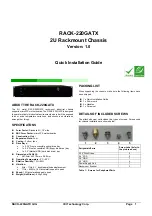
1-4
Cisco ASA Series CLI Configuration Guide
Appendix 1 Addresses, Protocols, and Ports
IPv4 Addresses and Subnet Masks
Class B-Size Network Address
To determine the network address to use with the subnet mask for a network with between 254 and
65,534 hosts, you need to determine the value of the third octet for each possible extended network
prefix. For example, you might want to subnet an address like 10.1.
x
.0, where the first two octets are
fixed because they are used in the extended network prefix, and the fourth octet is 0 because all bits are
used for the host number.
To determine the value of the third octet, follow these steps:
Step 1
Calculate how many subnets you can make from the network by dividing 65,536 (the total number of
addresses using the third and fourth octet) by the number of host addresses you want.
For example, 65,536 divided by 4096 hosts equals 16.
Therefore, there are 16 subnets of 4096 addresses each in a Class B-size network.
Step 2
Determine the multiple of the third octet value by dividing 256 (the number of values for the third octet)
by the number of subnets:
In this example, 256/16 = 16.
The third octet falls on a multiple of 16, starting with 0.
Therefore,
shows the 16 subnets of the network 10.1.
192.168.0.16
192.168.0.16 to 192.168.0.31
—
—
192.168.0.248
192.168.0.248 to 192.168.0.255
1.
The first and last address of a subnet are reserved. In the first subnet example, you cannot use 192.168.0.0 or 192.168.0.7.
Table 1-2
Class C-Size Network Address (continued)
Subnet with Mask /29 (255.255.255.248)
Address Range
1
Table 1-3
Subnets of Network
Subnet with Mask /20
(255.255.240.0)
Address Range
1
1.
The first and last address of a subnet are reserved. In the first subnet example, you cannot use
10.1.0.0 or 10.1.15.255.
10.1.0.0
10.1.0.0 to 10.1.15.255
10.1.16.0
10.1.16.0 to 10.1.31.255
10.1.32.0
10.1.32.0 to 10.1.47.255
—
—
10.1.240.0
10.1.240.0 to 10.1.255.255
Summary of Contents for 5505 - ASA Firewall Edition Bundle
Page 28: ...Glossary GL 24 Cisco ASA Series CLI Configuration Guide ...
Page 61: ...P A R T 1 Getting Started with the ASA ...
Page 62: ......
Page 219: ...P A R T 2 Configuring High Availability and Scalability ...
Page 220: ......
Page 403: ...P A R T 2 Configuring Interfaces ...
Page 404: ......
Page 499: ...P A R T 2 Configuring Basic Settings ...
Page 500: ......
Page 533: ...P A R T 2 Configuring Objects and Access Lists ...
Page 534: ......
Page 601: ...P A R T 2 Configuring IP Routing ...
Page 602: ......
Page 745: ...P A R T 2 Configuring Network Address Translation ...
Page 746: ......
Page 845: ...P A R T 2 Configuring AAA Servers and the Local Database ...
Page 846: ......
Page 981: ...P A R T 2 Configuring Access Control ...
Page 982: ......
Page 1061: ...P A R T 2 Configuring Service Policies Using the Modular Policy Framework ...
Page 1062: ......
Page 1093: ...P A R T 2 Configuring Application Inspection ...
Page 1094: ......
Page 1191: ...P A R T 2 Configuring Unified Communications ...
Page 1192: ......
Page 1333: ...P A R T 2 Configuring Connection Settings and QoS ...
Page 1334: ......
Page 1379: ...P A R T 2 Configuring Advanced Network Protection ...
Page 1380: ......
Page 1475: ...P A R T 2 Configuring Modules ...
Page 1476: ......
Page 1549: ...P A R T 2 Configuring VPN ...
Page 1550: ......
Page 1965: ...P A R T 2 Configuring Logging SNMP and Smart Call Home ...
Page 1966: ......
Page 2059: ...P A R T 2 System Administration ...
Page 2060: ......
Page 2098: ...1 8 Cisco ASA Series CLI Configuration Guide Chapter 1 Troubleshooting Viewing the Coredump ...
Page 2099: ...P A R T 2 Reference ...
Page 2100: ......









































